Experimental Studies on the Effect of Properties and Micro-Structure on the Creep of Concrete-Filled Steel Tubes
Abstract
:1. Introduction
- A 480-day experiment on the creep of concrete with lateral restraints was carried out.
- It was observed that the lateral restraint greatly reduces the creep degree in concrete.
- The influence of the mechanism of lateral restraint on creep was analyzed by means of the microstructure of concrete.
2. Materials and Methods
2.1. Materials
2.2. Experimental Design
3. Analysis of Test Results
3.1. Effect of Lateral Restraints on the Creep of Concrete
- When all specimens had 4% expansion agent, the creep ratio of the specimen with a steel ratio of 6.6% was about 0.42–0.71 times that with a steel ratio of 3.8%, while the creep ratio of the specimen with a steel ratio of 9.2% was about 0.44–0.58 times that with a steel ratio of 3.8%.
- When all specimens had 8% expansion agent, the creep ratio (coefficients) of the specimen with steel ratio of 6.6% was about 0.48–0.74 times that with a steel ratio of 3.8%, while the creep ratio (coefficients) of the specimen with a steel ratio of 9.2% was about 0.44–0.48 times that with a steel ratio of 3.8%.
- When all specimens had 12% expansion agent, the creep ratio (coefficients) of the specimen with a steel ratio of 6.6% was about 0.51–0.76 times that with a steel ratio of 3.8%, while the creep ratio (coefficients) of the specimen with a steel ratio of 9.2% was about 0.45–0.55 times that with a steel ratio of 3.8%.
3.2. The Effect of Expansion Agent on the Creep of the CFST
- When the steel ratio was 3.8%, with expansion agent concentrations of 8% and 12%, the creep ratios were about 0.865–0.910 and 0.825–0.863 times those of the 4% expansion agent, respectively, except for the first 240 h.
- When the steel ratio was 6.6%, with expansion agent concentrations of 8% and 12%, the creep ratios were about 0.895–0.932 and 0.869–0.964 times those of the 4% expansion agent, respectively, except for the first 2400 h.
- When the steel ratio was 9.2%, with expansion agent concentrations of 8% and 12%, the creep ratios were about 0.932–0.976 and 0.873–0.915 times those of the 4% expansion agent, respectively, except for the first 240 h.
- When the concrete specimens contained 8% and 12% expansion agent but no lateral loading, the creep ratios were about 0.841–0.886 and 0.778–0.817 times those of the 4% expansion agent, respectively.
4. The Analysis of the Micro Pore Structure
4.1. Effect of Lateral Restraints on Concrete Pore Structure under Different Conditions
4.2. Effect of the Concentration of Expansion Agent Content on the Core concrete Pore Structure
5. Conclusions
- Analyses on 12 creep test results reveal that creep ratios of the concrete specimens with lateral restraint are about 0.09–0.30 times smaller than those without lateral restraint. Meanwhile, the creep ratio of CFST specimens decreases as the steel ratio increases.
- Creep ratio decreases as expansion agent concentration increases.
- According to analyses on the microscopic pore structures of concrete specimens, the percentage of air content and the number of bubble chords of the core concrete with lateral restraint are lower than those without lateral restraint. Air content and the number of bubble chords reach the highest values in the core concrete with a 4% expansion agent, followed by core concrete with 8% expansion agent and then with 12% expansion agent.
- The lateral restraint and the expansion agent concentrations have a combined effect on the creep of the core concrete, so selecting the appropriate lateral restraint and the best content for the expansion agent can effectively reduce the creep of concrete.
- The key contribution of this study is the finding that CFSTs require an optimum combination of proper lateral restraint and an optimum ratio of expansion agent in order to effectively reduce the creep and thus improve the long-term service of concrete structures.
Author Contributions
Funding
Acknowledgments
Conflicts of Interest
References
- Zhong, S.T. Unified theiry of concrete-filled steel tube — research and application; Tsinghua University Press: Beijing, China, 2006. [Google Scholar]
- Wang, Y.B.; Liew, J.R. Constitutive model for confined ultra-high strength concrete in steel tube. Construct. Build. Mater. 2016, 126, 812–822. [Google Scholar] [CrossRef]
- Shams, M.; Saadeghvaziri, M.A. Nonlinear response of concrete-filled steel tubular columns under axial loading. Struct. J. 1999, 96, 1009–1017. [Google Scholar]
- Roeder, C.W.; Brown, C.B. Composite action in concrete filled tubes. J. Struct. Eng. 1999, 125, 477–484. [Google Scholar] [CrossRef]
- Pignatelli, I.; Kumar, A.; Alizadeh, R.; Le Pape, Y.; Bauchy, M.; Sant, G. A dissolution-precipitation mechanism is at the origin of concrete creep in moist environments. J. Chem. Phys. 2016, 145, 054701. [Google Scholar] [CrossRef] [PubMed]
- Su, L.; Wang, Y.F.; Mei, S.Q.; Li, P.F. Experimental investigation on the fundamental behavior of concrete creep. Construct. Build. Mater. 2017, 152, 250–258. [Google Scholar] [CrossRef]
- Zhang, R.L.; Wang, Q.C.; Ma, L.N.; Qi, L.F.; Qi, Q. Effect of expanding agent proportion and lateral confinement by steel tube on the creep strain of concrete. Acta Mater. Compos. Sin. 2017, 34, 2099–2105. (In Chinese) [Google Scholar]
- Bary, B.; He, Q.C.; Thai, M.Q. Coupled Damage and Multiscale Creep Model Applied to Cementitious Materials. In Proceedings of the International Conference on Creep, Shrinkage, and Durability Mechanics, Cambridge, CA, USA, 22–25 September 2013; pp. 219–226. [Google Scholar]
- Zhang, R.L.; Wang, Q.C.; Ma, L.N.; Yang, Y.; Qi, L.F. Effect of expanding agent proportion and stress ratio on the creep characteristics of concrete filed steel tube. J. Cent. South Univ. Sci. Technol. 2014, 45, 2146–2423. (In Chinese) [Google Scholar]
- Luo, J.; Xu, Z.; Xie, B. Shrinkage and creep properties of different grade recycled aggregate concretes. J. Cent. South Univ. 2013, 44, 3815–3822. (In Chinese) [Google Scholar]
- Bažant, Z.P.; Jirásek, M. Basic Properties of Concrete Creep, Shrinkage, and Drying. In Creep and Hygrothermal Effects in Concrete Structures; Springer: Basingstoke, UK, 2018. [Google Scholar]
- Huang, Y.; Hamed, E. Buckling of one-way high-strength concrete panels: Creep and shrinkage effects. J. Eng. Mech. 2013, 139, 1856–1867. [Google Scholar] [CrossRef]
- Zhang, Q.; Le Roy, R.; Vandamme, M.; Zuber, B. Long-term creep properties of cementitious materials—Comparing compression tests on concrete with microindentation tests on cement. In Proceedings of the Fifth Biot Conference on Poromechanics (Poromechanics V), Vienna, Austria, 10–12 July 2013; pp. 1596–1604. [Google Scholar]
- Charpin, L.; Le Pape, Y.; Coustabeau, É.; Toppani, É.; Heinfling, G.; Le Bellego, C.; Masson, B.; Montalvo, J.; Courtois, A.; Sanahuja, J.; et al. A 12 year EDF study of concrete creep under uniaxial and biaxial loading. Cem. Concr. Res. 2018, 103, 140–159. [Google Scholar] [CrossRef]
- Wendner, R.; Hubler, M.H.; Bažant, Z.P. The B4 Model for Multi-decade Creep and Shrinkage Prediction. In Proceedings of the International Conference on Creep, Shrinkage, and Durability Mechanics, Cambridge, CA, USA, 22–25 September 2013; pp. 429–436. [Google Scholar]
- Rahimi-Aghdam, S.; Bažant, Z.P.; Cusatis, G. Extended microprestress-solidification theory for long-term creep with diffusion size effect in concrete at variable environment. J. Eng. Mech. 2019, 145, 131–144. [Google Scholar] [CrossRef]
- Anders, I.; Müller, H.S. Material Law on the Time-dependent Stress-strain Behavior of Young Concretes. In Proceedings of the International Conference on Creep, Shrinkage, and Durability Mechanics, Cambridge, CA, USA, 22–25 September 2013; pp. 467–474. [Google Scholar]
- Cao, G.H.; Hu, J.X.; Zhang, K.; He, M. Correction analysis on prediction model of concrete creep. Build. Struct. 2014, 44, 45–49. (In Chinese) [Google Scholar]
- Gholampour, A.; Ozbakkaloglu, T. Time-dependent and long-term mechanical properties of concretes incorporating different grades of coarse recycled concrete aggregates. Eng. Struct. 2018, 157, 224–234. [Google Scholar] [CrossRef]
- Reddy, D.H.; Ramaswamy, A. Experimental and numerical modeling of creep in different types of concrete. Heliyon 2018, 4, e00698. [Google Scholar]
- Müller, S.H.; Eckhardt, J.D.; Haist, M. New Experimental Approach to Study Creep and Shrinkage Mechanisms of Concrete on the Nano-scale Level. In Proceedings of the International Conference on Creep, Shrinkage, and Durability Mechanics, Cambridge, CA, USA, 22–25 September 2013; pp. 150–157. [Google Scholar]
- Neville, A.M.; Walter, H.; Dilger, J.J. Creep of plain and structural Concrete. Construction Press: London, UK, 1983; pp. 42–51. [Google Scholar]
- Giorla, A.B.; Dunant, C.F. Microstructural effects in the simulation of creep of concrete. Cem. Concr. Res. 2018, 105, 44–53. [Google Scholar] [CrossRef]
- Han, L.H.; Yang, Y.F.; Liu, W. The behavior of concrete-filled steel tubular columns with rectangular section under of long-term loading. Chin. Civ. Eng. J. 2004, 3, 12–18. [Google Scholar]
- Chen, Z.; Zhang, S.; Wang, N.; Xue, J.; Chen, B. Experimental study and theoretical analysis on axial compress capacity of recycled aggregate concrete-filled circle steel tube short column. Eng. Mech. 2013, 30, 107–114. [Google Scholar]
- Zhang, R.L.; Yang, Y.; Wang, Q.C.; Ma, L.N.; Qi, Q. Effect of Pore Structures on the Creep Characteristics of Micro-expanded Concrete Filled Steel Tube. Bull. Chin. Ceram Soc. 2014, 33, 1514–1519. [Google Scholar]
- Xie, N.; Yang, C.Y.; Ouyang, J.; Yin, Z.H. Experimental research and prediction on shotcrete creep at early age. J. Civ. Eng. 2013, 37, 365–370. [Google Scholar]
- Zhang, R.; Wang, L.; Yang, C.; Yang, B.; Zhu, C.; Hao, Q. Simulation analysis of shrinkage and creep for bowstring arch bridge steel tube concrete in different specification. Appl. Mech. Mater. 2012, 178–181, 2219–2223. [Google Scholar] [CrossRef]
- GB/T 50082-2009 Stangard for test methods of long-term performance and durability of ordinary concrete; Standards China: Beijing, China, 2009.
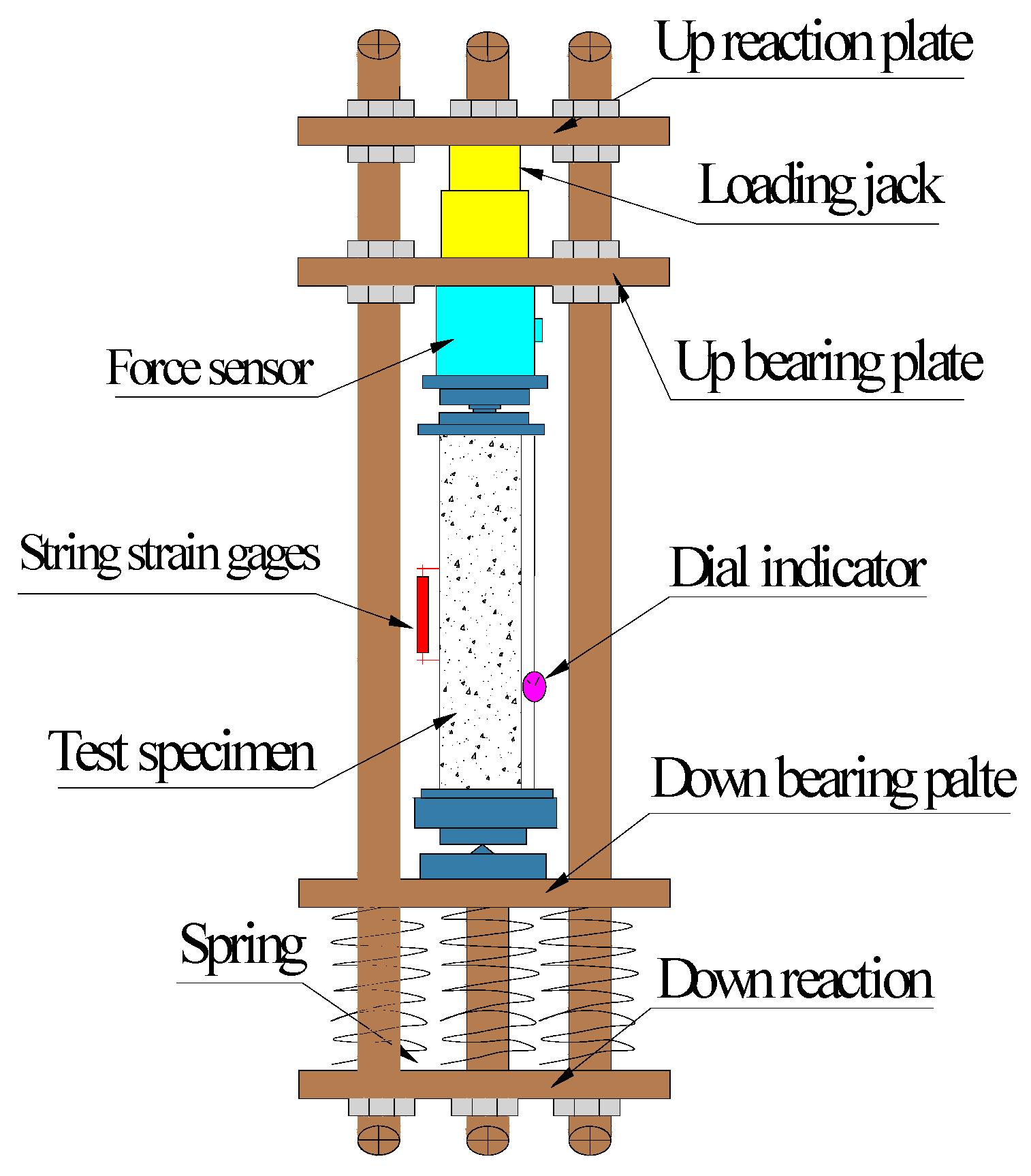
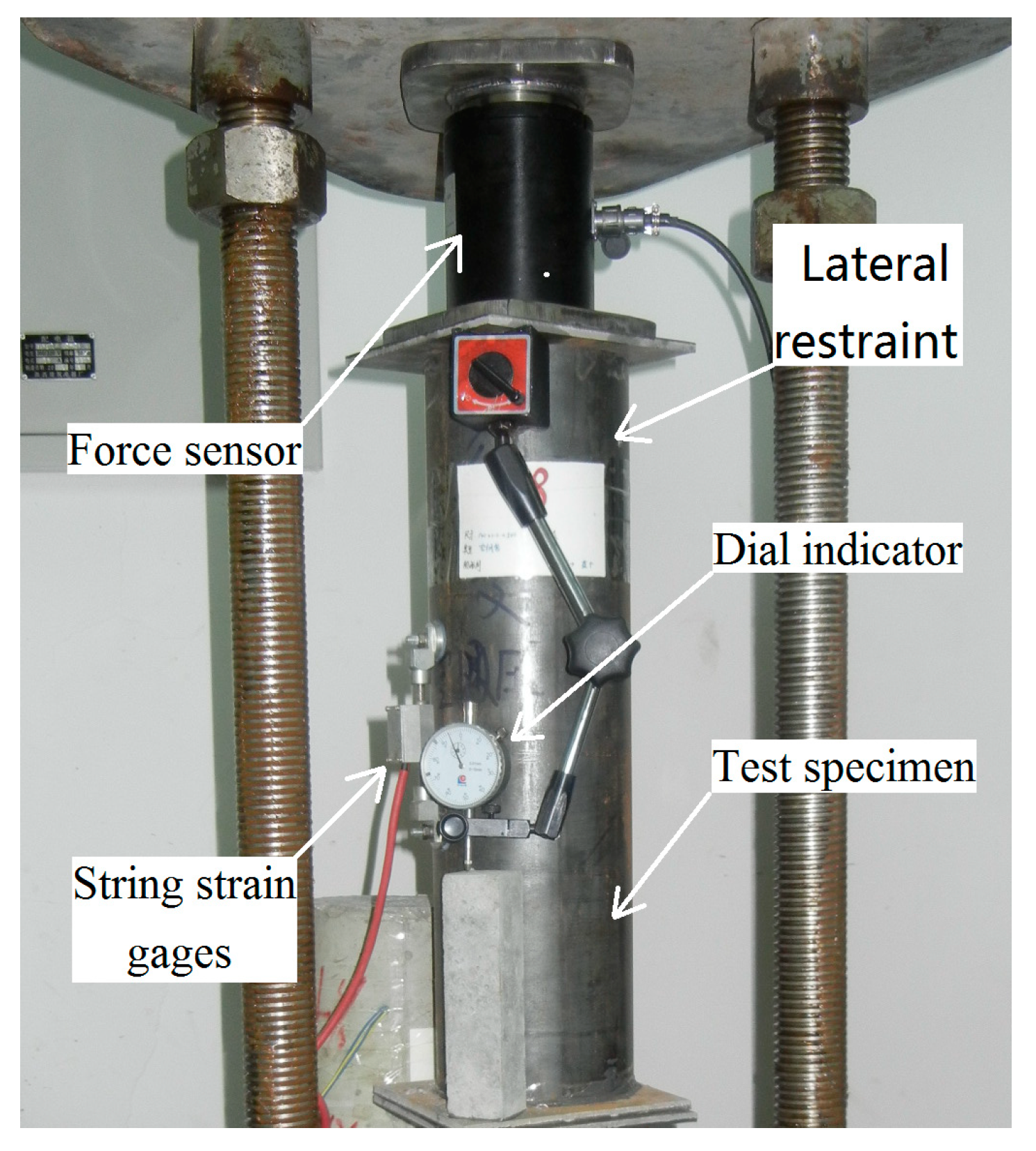
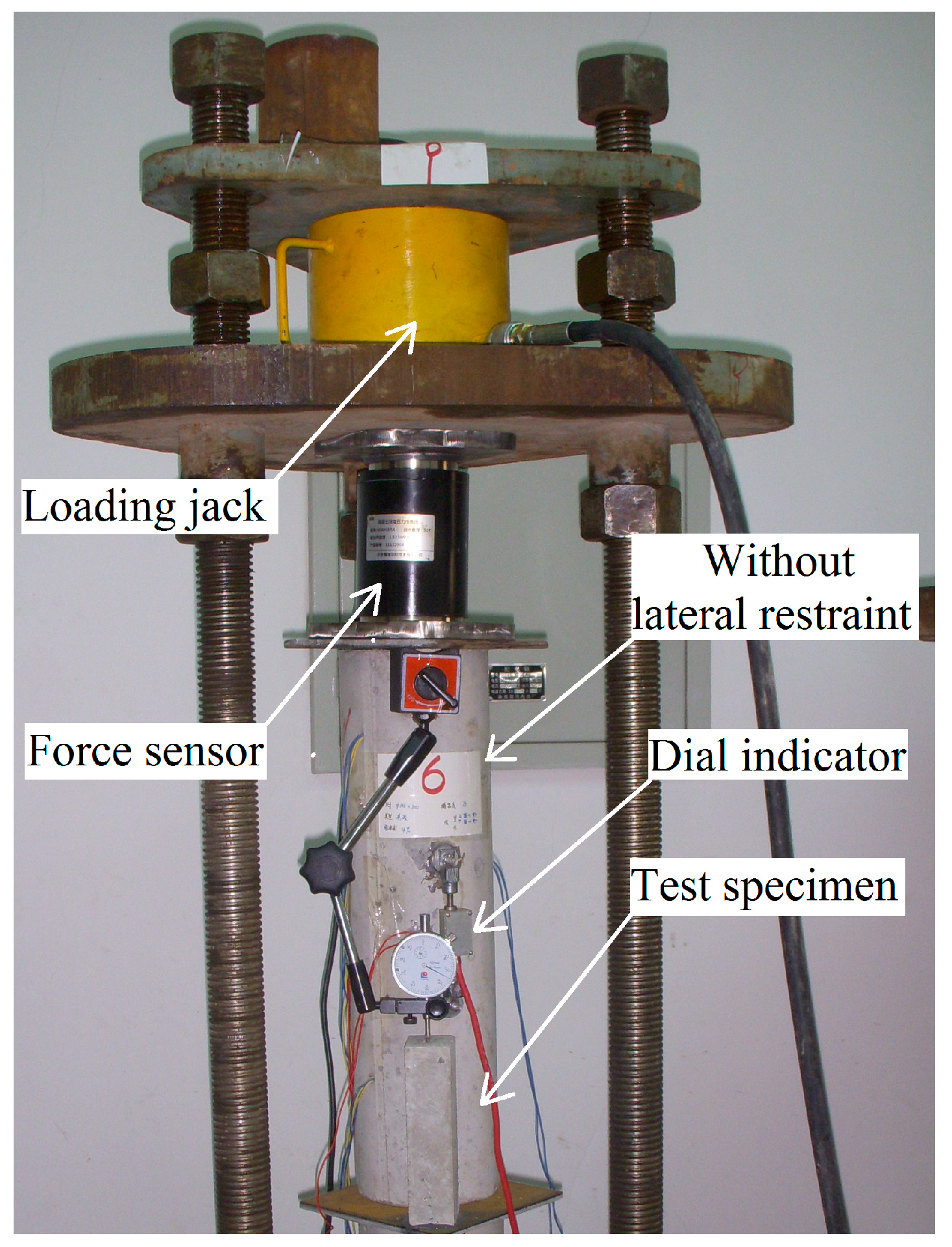
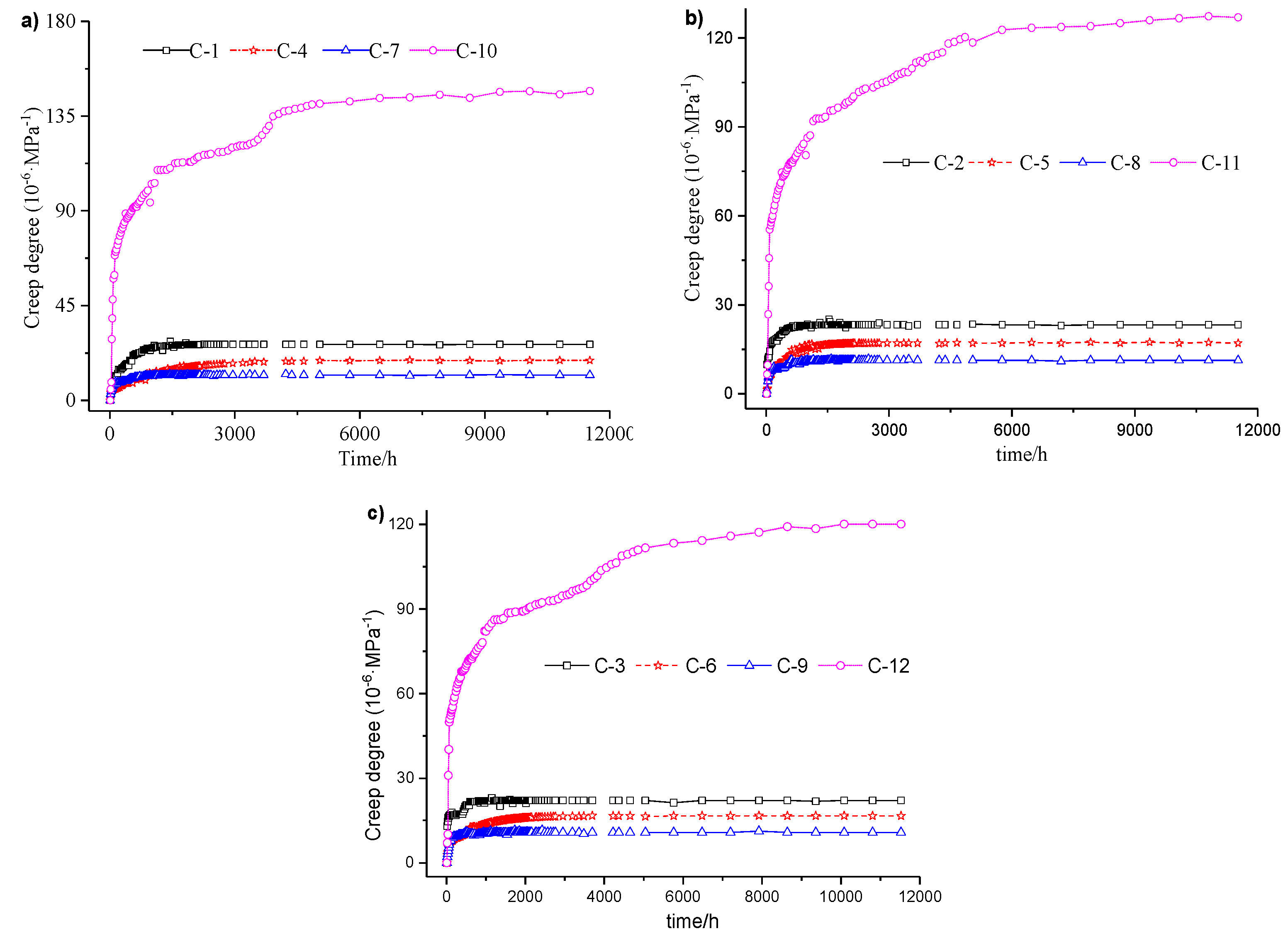
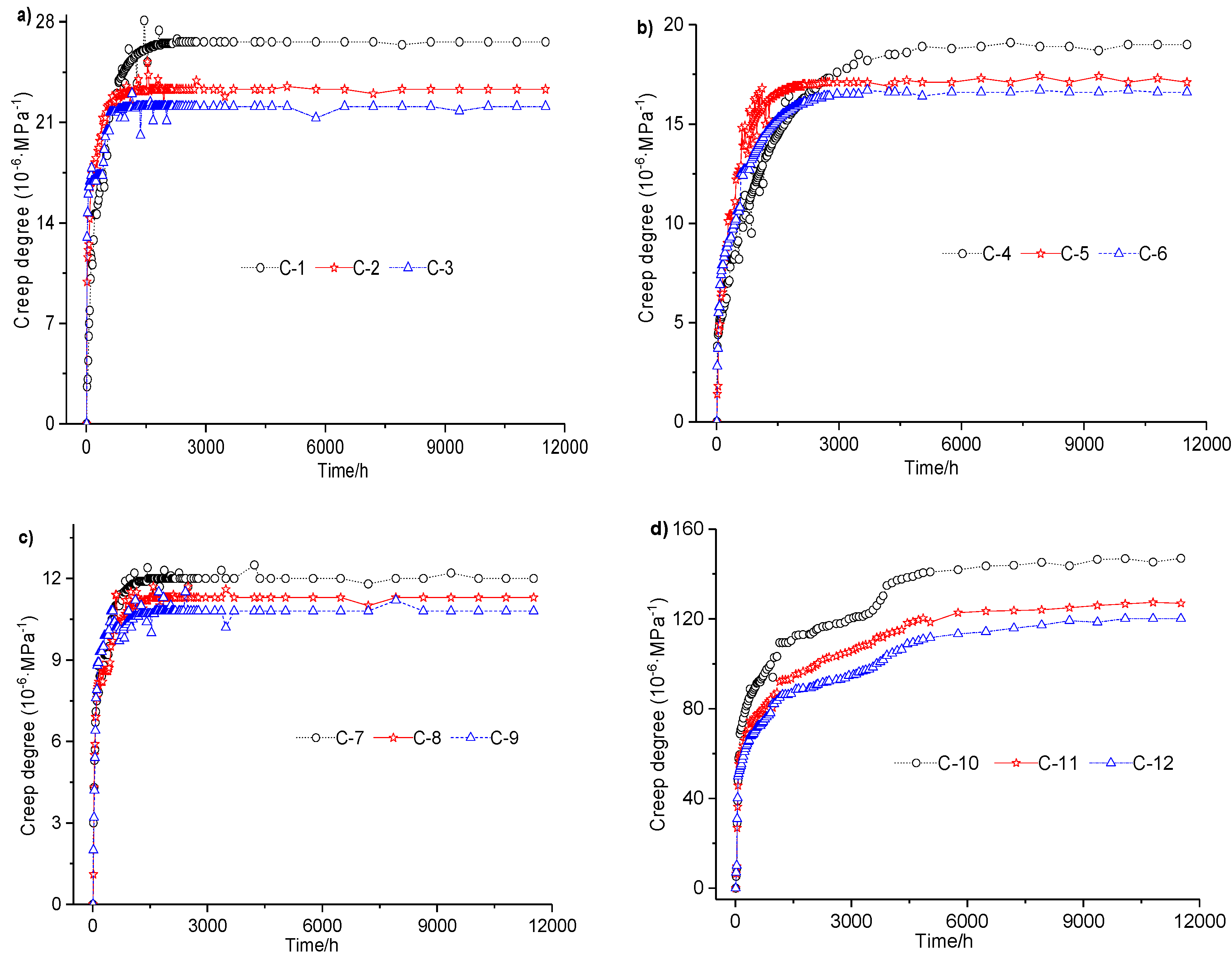
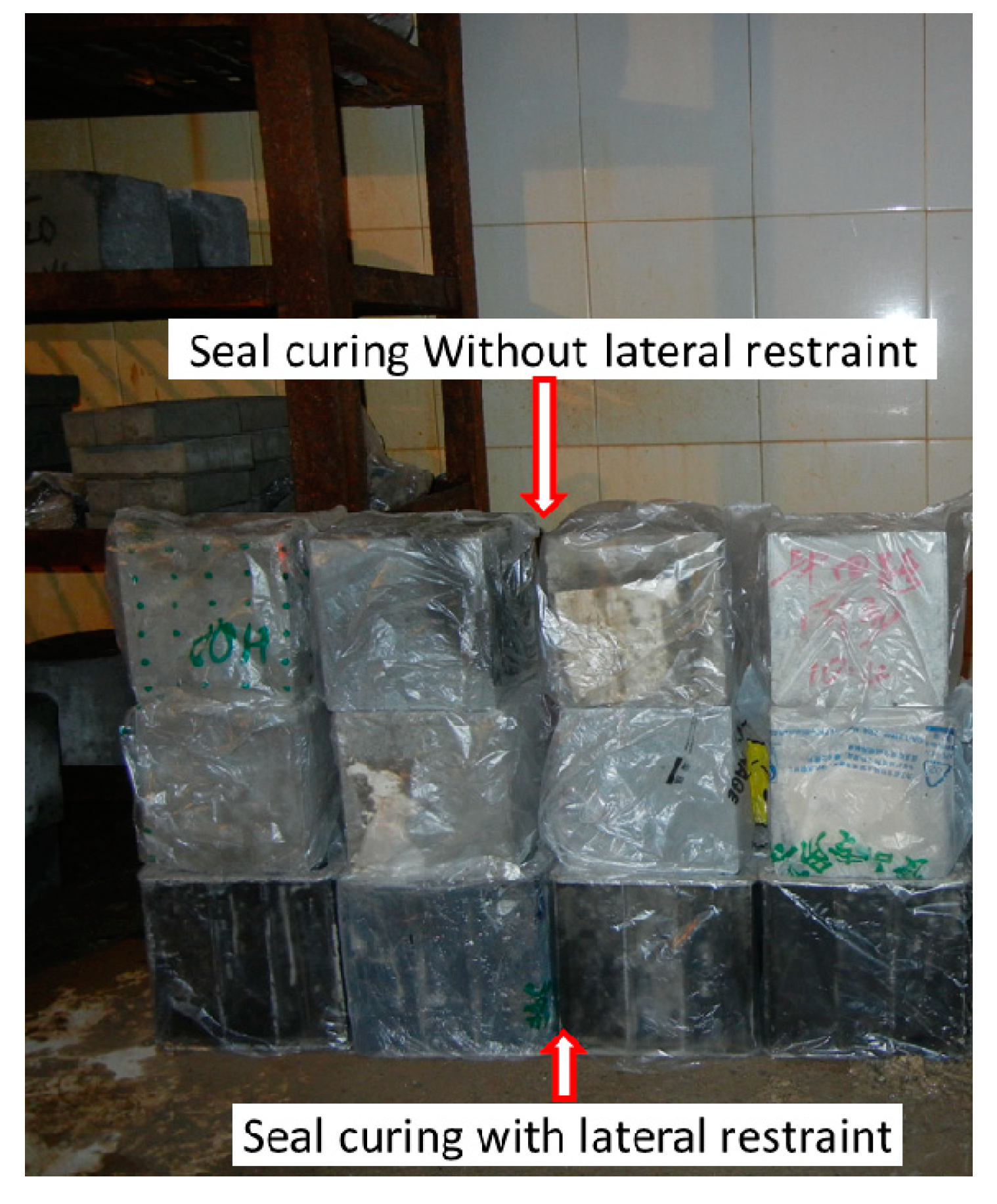

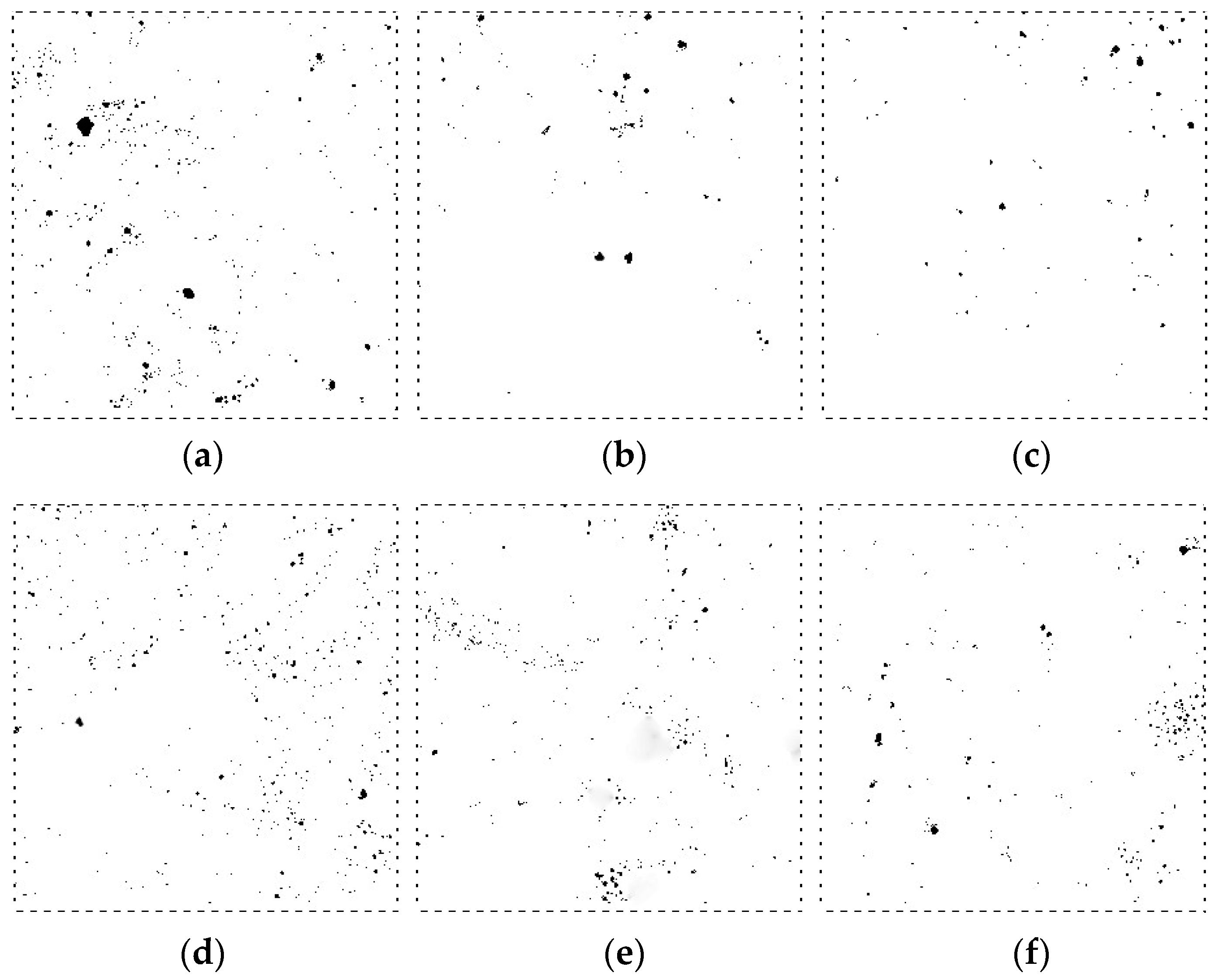
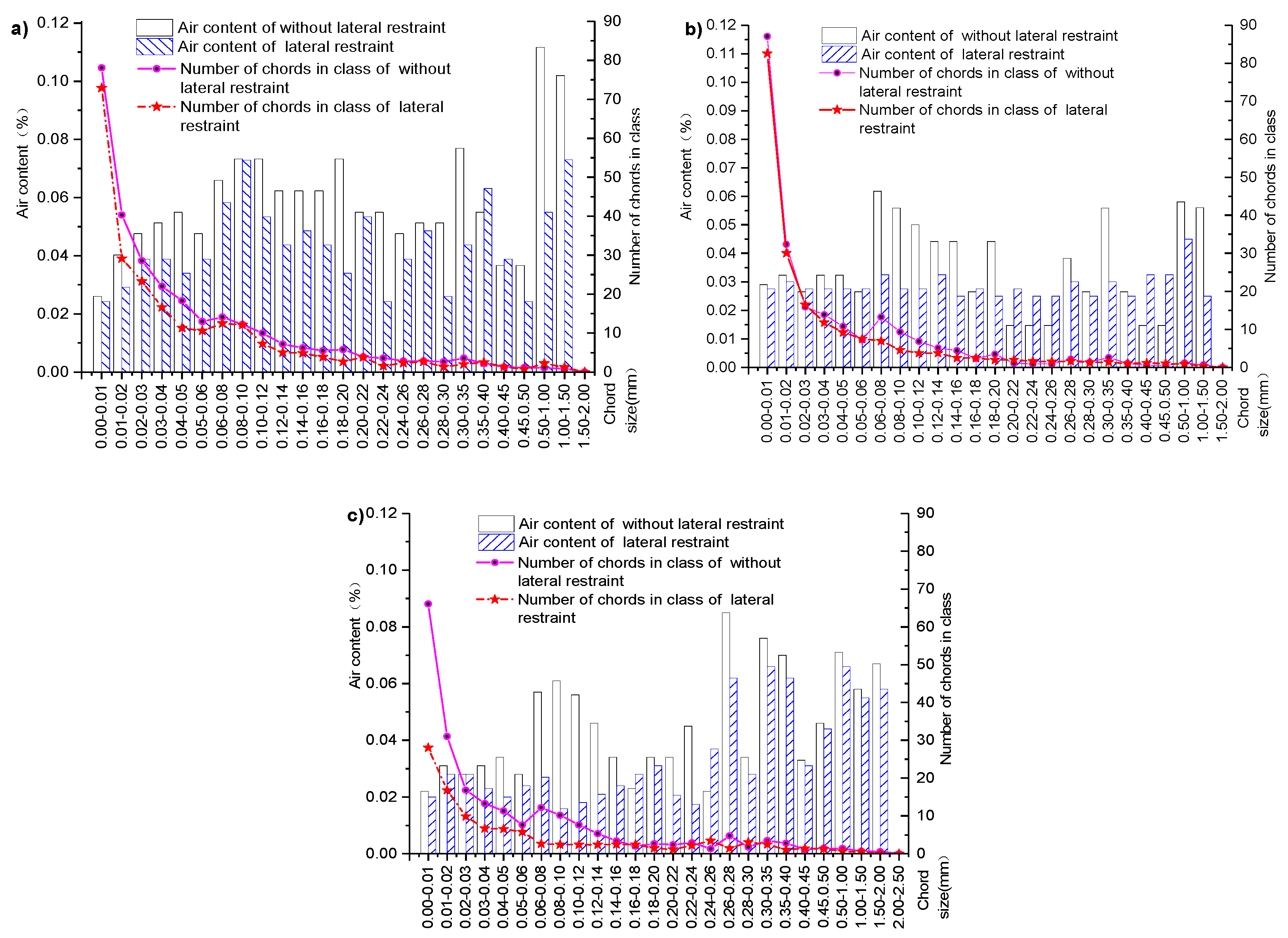
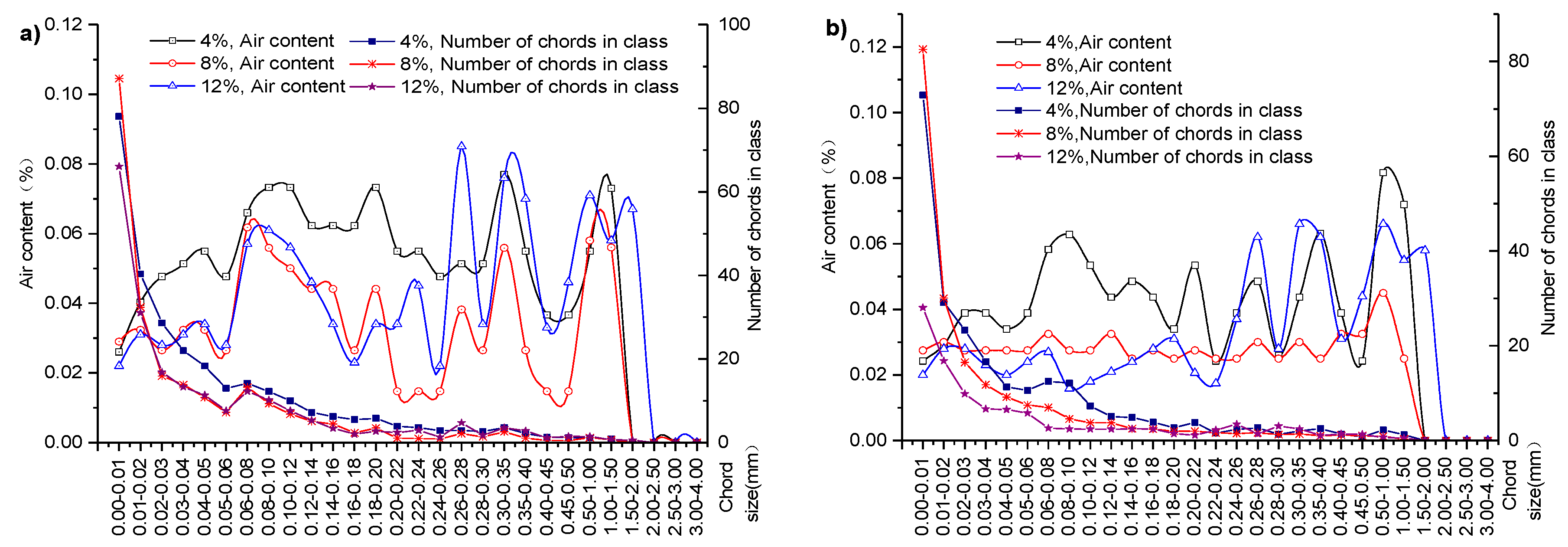
| Material | Volume Stability (mm) | Sulfur Trioxide (%) | Chloride Ion (%) | Alkali Content (%) | Loss on Ignition (%) | Initial Setting (min) | Final Setting (min) | Compressive Strength (MPa) | |
|---|---|---|---|---|---|---|---|---|---|
| 3 d | 28 d | ||||||||
| Cement | 2 | 2.44 | 0.012 | 0.43 | 1.52 | 185 | 325 | 21.7 | 48.6 |
| Material | Specific Surface Area (m2/kg) | Chloride Ion Content (%) | Water Content (%) | Sulfur Trioxide (%) | Free Calcium Oxide (%) | Fluidity Rate (%) | Fineness (%) | Water Demand (%) | Alkali Content (%) | Loss on Ignition (%) | Activity Index (%) | |
|---|---|---|---|---|---|---|---|---|---|---|---|---|
| H7 | H28 | |||||||||||
| Slag | 448 | 0.016 | – | 1.90 | – | 97 | – | – | 0.36 | 0.19 | 79 | 97 |
| Fly ash | - | 0.01 | 0.25 | 1.4 | 0.6 | – | 8.6 | 82 | 0.81 | 3.2 | – | – |
| Type | Magnesium Oxide Content (%) | Total Alkali Content (%) | Chloride Ion (%) | Surface Areas (m2/kg) | Initial Setting (min) | Final Setting (min) | Restrained Expansion Rate | Compressive Strength (MPa) | ||
|---|---|---|---|---|---|---|---|---|---|---|
| Water 7 d | Air 21 d | 7 d | 28 d | |||||||
| UEA-H | 3.38 | 0.58 | 0.009 | 316 | 174 | 259 | 0.036 | −0.019 | 22.2 | 40.3 |
| Type | Water Reducing Ratio (%) | Bleeding Rate (%) | Air Content (%) | Air Content Changing within 1 h (%) | Shrinkage Ratio (%) | Initial Setting (min) | Final Setting (min) | Compressive Strength Ratio (%) | ||
|---|---|---|---|---|---|---|---|---|---|---|
| 3 d | 7 d | 28 d | ||||||||
| AN1 | 7.8 | 50 | 6.0 | +1.3 | 121 | +25 | +30 | 96 | 97 | 95 |
| AN4000 | 30.0 | 6.0 | 2.8 | 35 | 100 | +105 | +110 | 173 | 160 | 155 |
| Type | Tensile Strength (MPa) | Yield Strength (MPa) | Elongation (Min) | Shear Strength (MPa) | Elasticity Modulus (MPa) | Shear Modulus (MPa) | Coefficient of Linear Expansion (°C) | Mass Density (kg/m3) |
|---|---|---|---|---|---|---|---|---|
| Q345 | 560 | 347 | 26 | 182 | 2.04 × 105 | 7.9 × 104 | 1.2×10−5 | 7853 |
| Specimen | Lateral Restraint | Expansion Agent Dosage % | Steel Ratio % | Structure Size | Mixture Ratio Kg/m3 | ||||||
|---|---|---|---|---|---|---|---|---|---|---|---|
| (D × t × H) mm | Cement | Expansion Agent | Fine Aggregate | Coarse Aggregates | Fly Ash | Mineral Powder | Water | ||||
| C-1 | YES | 4 | 3.8 | φ140.0 × 1.3 × 350 | 368 | 19.6 | 740 | 1023 | 73 | 49 | 158.76 |
| C-2 | YES | 8 | 3.8 | φ140.0 × 1.3 × 350 | 368 | 39.2 | 740 | 1023 | 73 | 49 | 158.76 |
| C-3 | YES | 12 | 3.8 | φ140.0 × 1.3 × 350 | 368 | 58.8 | 740 | 1023 | 73 | 49 | 152.88 |
| C-4 | YES | 4 | 6.6 | φ140.0 × 2.2 × 350 | 368 | 19.6 | 740 | 1023 | 73 | 49 | 158.76 |
| C-5 | YES | 8 | 6.6 | φ140.0 × 2.2 × 350 | 368 | 39.2 | 740 | 1023 | 73 | 49 | 164.64 |
| C-6 | YES | 12 | 6.6 | φ140.0 × 2.2 × 350 | 368 | 58.8 | 740 | 1023 | 73 | 49 | 152.88 |
| C-7 | YES | 4 | 9.2 | φ140.0 × 3.0 × 350 | 368 | 19.6 | 740 | 1023 | 73 | 49 | 158.76 |
| C-8 | YES | 8 | 9.2 | φ140.0 × 3.0 × 350 | 368 | 39.2 | 740 | 1023 | 73 | 49 | 164.64 |
| C-9 | YES | 12 | 9.2 | φ140.0 × 3.0 × 350 | 368 | 58.8 | 740 | 1023 | 73 | 49 | 158.76 |
| C-10 | NO | 4 | 0.0 | φ135.6 × 0.0 × 350 | 368 | 19.6 | 740 | 1023 | 73 | 49 | 158.76 |
| C-11 | NO | 8 | 0.0 | φ135.6 × 0.0 × 350 | 368 | 19.6 | 740 | 1023 | 73 | 49 | 158.76 |
| C-12 | NO | 12 | 0.0 | φ135.6 × 0.0 × 350 | 368 | 19.6 | 740 | 1023 | 73 | 49 | 158.76 |
| Time (h) | C-1/C-10 | C-4/C-10 | C-7/C-10 | C-2/C-11 | C-5/C-11 | C-8/C-11 | C-3/C-12 | C-6/C-12 | C-9/C-12 |
|---|---|---|---|---|---|---|---|---|---|
| 240 | 0.19 | 0.08 | 0.11 | 0.28 | 0.13 | 0.12 | 0.28 | 0.14 | 0.15 |
| 1200 | 0.23 | 0.12 | 0.11 | 0.25 | 0.16 | 0.12 | 0.26 | 0.17 | 0.12 |
| 2400 | 0.23 | 0.14 | 0.10 | 0.23 | 0.17 | 0.11 | 0.24 | 0.18 | 0.12 |
| 3600 | 0.21 | 0.15 | 0.10 | 0.21 | 0.15 | 0.10 | 0.22 | 0.17 | 0.11 |
| 4800 | 0.19 | 0.13 | 0.09 | 0.20 | 0.14 | 0.09 | 0.20 | 0.15 | 0.10 |
| 7200 | 0.18 | 0.13 | 0.08 | 0.19 | 0.14 | 0.09 | 0.19 | 0.14 | 0.09 |
| 9600 | 0.18 | 0.13 | 0.08 | 0.18 | 0.14 | 0.09 | 0.18 | 0.14 | 0.09 |
| 11520 | 0.18 | 0.13 | 0.08 | 0.18 | 0.13 | 0.09 | 0.18 | 0.14 | 0.09 |
| Specimen | Steel Ratio % | Standard Confinement Coefficient ξ | Standard Value of Combined Compressive Strength (MPa) | Distribution Coefficient of Concrete Load | Distribution Coefficient of Steel Tube Load | Stress Ratio |
|---|---|---|---|---|---|---|
| C-2 | 3.8 | 0.253 | 53.002 | 0.823 | 0.177 | 0.288 |
| C-5 | 6.6 | 0.437 | 59.810 | 0.729 | 0.271 | 0.256 |
| C-8 | 9.2 | 0.606 | 65.767 | 0.660 | 0.340 | 0.232 |
| C-10 | 0.0 | 0.000 | 43.026 | 1.000 | 0.000 | 0.379 |
| Time/h | C-2/C-1 | C-3/C-1 | C-5/C-4 | C-6/C-4 | C-8/C-7 | C-9/C-7 | C-11/C-10 | C-12/C-10 |
|---|---|---|---|---|---|---|---|---|
| 240 | 1.267 | 1.158 | 1.419 | 1.419 | 0.976 | 1.107 | 0.841 | 0.778 |
| 1200 | 0.910 | 0.863 | 1.128 | 1.090 | 0.933 | 0.891 | 0.848 | 0.788 |
| 2400 | 0.876 | 0.831 | 1.012 | 0.964 | 0.942 | 0.900 | 0.879 | 0.787 |
| 3600 | 0.867 | 0.831 | 0.932 | 0.905 | 0.954 | 0.875 | 0.886 | 0.794 |
| 4800 | 0.880 | 0.831 | 0.915 | 0.880 | 0.942 | 0.900 | 0.855 | 0.789 |
| 7200 | 0.865 | 0.831 | 0.895 | 0.869 | 0.932 | 0.915 | 0.860 | 0.805 |
| 9600 | 0.876 | 0.825 | 0.915 | 0.883 | 0.934 | 0.893 | 0.861 | 0.814 |
| 11520 | 0.876 | 0.831 | 0.900 | 0.874 | 0.942 | 0.900 | 0.864 | 0.817 |
© 2019 by the authors. Licensee MDPI, Basel, Switzerland. This article is an open access article distributed under the terms and conditions of the Creative Commons Attribution (CC BY) license (http://creativecommons.org/licenses/by/4.0/).
Share and Cite
Zhang, R.; Ma, L.; Wang, Q.; Li, J.; Wang, Y.; Chen, H.; Samosvat, V. Experimental Studies on the Effect of Properties and Micro-Structure on the Creep of Concrete-Filled Steel Tubes. Materials 2019, 12, 1046. https://doi.org/10.3390/ma12071046
Zhang R, Ma L, Wang Q, Li J, Wang Y, Chen H, Samosvat V. Experimental Studies on the Effect of Properties and Micro-Structure on the Creep of Concrete-Filled Steel Tubes. Materials. 2019; 12(7):1046. https://doi.org/10.3390/ma12071046
Chicago/Turabian StyleZhang, Rongling, Lina Ma, Qicai Wang, Jia Li, Yu Wang, Huisu Chen, and Valeriia Samosvat. 2019. "Experimental Studies on the Effect of Properties and Micro-Structure on the Creep of Concrete-Filled Steel Tubes" Materials 12, no. 7: 1046. https://doi.org/10.3390/ma12071046
APA StyleZhang, R., Ma, L., Wang, Q., Li, J., Wang, Y., Chen, H., & Samosvat, V. (2019). Experimental Studies on the Effect of Properties and Micro-Structure on the Creep of Concrete-Filled Steel Tubes. Materials, 12(7), 1046. https://doi.org/10.3390/ma12071046





